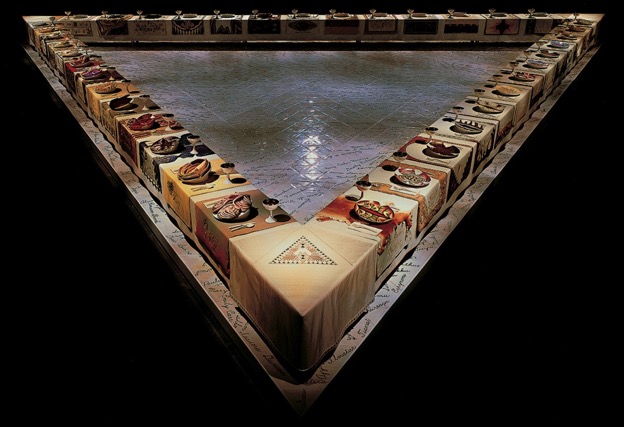
The era of global interconnection seemly questions who is seated at the table, the table being the grandiose metaphor of democracy, power and representation in society. In the West, this metaphorical table has been predominantly dominated by the white male (Huggan & Law, 2009). This is not to simply allocate the white-male as the “victimizer” of the “powerless victim”. However, it does call into question several of the previous power structures, particularly regarding the representation of the artworld and society.
Historical representation in the artworld has been under a patriarchal system riddled with exclusiveness, lack of diversity, and men as the normalized power-holders (Garlick, 2004; Ellis-Perterson, 2017). Therefore, from a historical perspective the metaphorical table has been dominated by more or less one single demographic group (ibid). Now, whether you accept the use of identity politics or not, feminist and de-colonial theories have certainly been used as a strategy to answer who is really seated at the table. Despite their valuable contributions, it seems that these theories, as used to challenge power paradigms in society, may not be enough (Chua, 2018). Professor of law at Yale Law School, Amy Chua’s (2018), explains our tribal-instincts co-opt identity politics as an effective strategy for representation and diversity when concerning political power and change. None of this is to deny the use of these theories in today’s society. On the contrary, by invoking Chua’s critical perspective over the issue, she questions the mechanisms for real, effective, political change (Chua, 2018).
Enter activist art. The noted London art museum, Tate Modern, explains that “activist art is about empowering individuals and communities and is generally situated in the public arena with artists working closely with a community to generate the art” (Tate Modern, 2018). Therefore, this definition of activist art comes at the very intersection between the arts and political activism, two fields defined by a shared focus of creating engagement that shifts boundaries, changes relations, and creates new paradigms (Blum, 2016).
My research with EUrArt focuses on investigating activist art by asking what the consequences and outcomes of certain artists’ attempts at social activism in Europe have been. The focus will be on the implementation by both grass-roots and institutional actors in the artworld, as well as their strategy for influencing the social-political discourse; in my research I will call this creative intervention strategy. This theoretical strategy is specifically concerned with how activist artist and art institutions function as cultural producers to gain attention and in some cases, influence policy toward today’s issues through the use of creativity and protest. An example being performance artist and poet, Quinsy Gario’s 2011 protest, “Zwarte Piet is Racism” in Dordrecht, Netherlands (Dam Bracia, 2016). The protest became an iconic artistic display, and later cultural movement, challenging normative traditions in Dutch society particularly concerning Dutch identities, symbolism, and race in their cultural heritage (ibid).
Scaled to a broader European view, cases like Garios and others call into question the representation of power holders and cultural narratives in society into question. My research is focused on what policies should be put in place to protect these creative intervention strategies – for there is an urgent need for a strategy that emphasizes the aesthetics of inclusivity, an ethos of unity, and has a practical application.
Next up: Black letters v. colorful artwork. What the law and the arts have in common, you ask? The answer may surprise you, so be sure to read Despoina’s article next week!
By Adam Rakestraw, Searcher of the EUrArt Working Group.
Bibliography
- Blum, A. (2018). Art and Politics: The Power of Creativity and Activism Across the Globe. Huffington Post. Published on March, 21st. Retrieved May 12th. 2018, from: https://www.huffingtonpost.com/annette-blum/art-and-politicsthe-power_b_9511384.html
- Chua, A. (2018). Political Tribes: Group Instinct and the Fate of Nations. Penguin Press, New York.
- Dam Bracia, L. (2016). “Zwarte Piet is Rascism”: The Dutch Cultural Tradition of Blackface. Ayiba Magazine. Retrieved February 18th, 2018, from: http://ayibamagazine.com/zwarte-piet-racism/
- Garlick, S. (2004). Distinctly Feminine: On the Relationship Between Men and Art. Berkeley Journal of Sociology, Vol. 48, pp. 108-125.
- Huggan, G. & Law, I. (2009). Postcolonialism Across the Disciplines: Racism and Post- Colonialism in Europe. Liverpool University Press. October.
- Ellis-Peterson, H. (2017). How the Artworld Airbrushed Females from History. The Guardian. Published on February 6th, 2017. Retrieved May 10th, 2018 from: https://www.theguardian.com/lifeandstyle/2017/feb/06/how-the-art-world-airbrushed-female-artists-from-history
- Tate Modern (2018). Art Term: Activist Art. London. Retrieved April 20th, 2018, from: http://www.tate.org.uk/art/art-terms/a/activist-art

 The geopolitical role of the Sahel: the influence of the EU and other Great Powers in the Malian crisis
The geopolitical role of the Sahel: the influence of the EU and other Great Powers in the Malian crisis  Is Nuclear Disarmament Still a Dream? The Third Meeting of State Parties in Perspective
Is Nuclear Disarmament Still a Dream? The Third Meeting of State Parties in Perspective  Strategic Saboteur: Hungary’s Entrenched Illiberalism and the Fracturing of EU Cohesion
Strategic Saboteur: Hungary’s Entrenched Illiberalism and the Fracturing of EU Cohesion  The invention of development: power, narrative, and the afterlife of Truman’s speech
The invention of development: power, narrative, and the afterlife of Truman’s speech 


